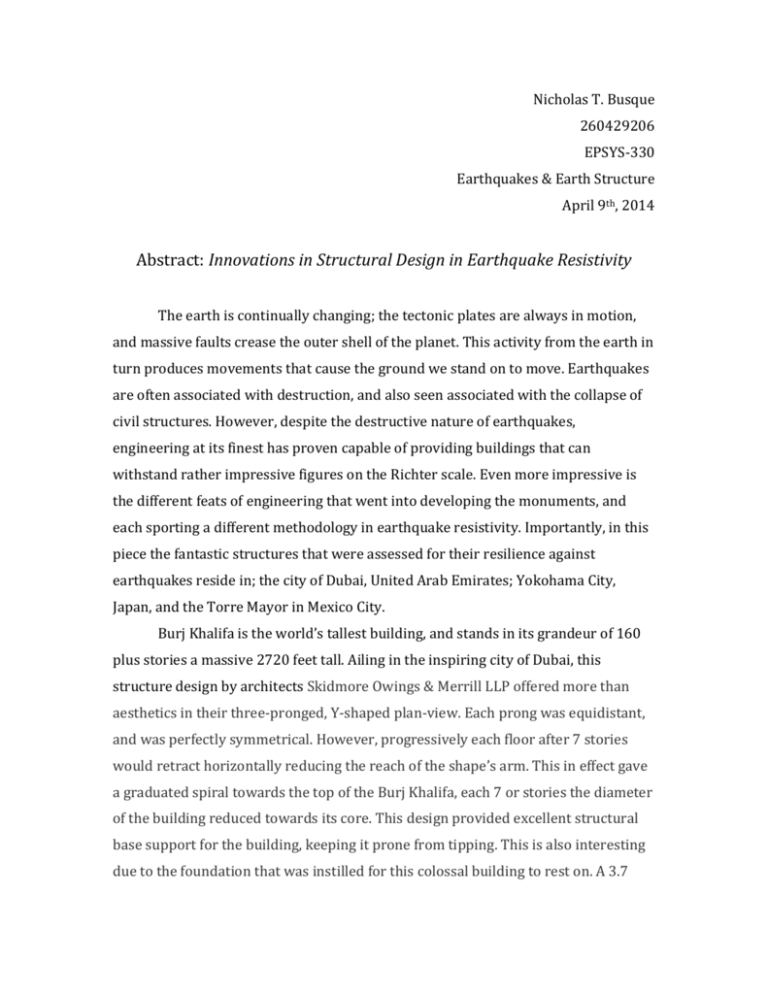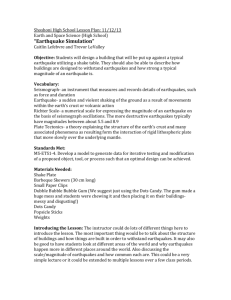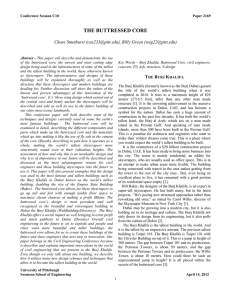Abstrat-EPSYS330
advertisement

Nicholas T. Busque 260429206 EPSYS-330 Earthquakes & Earth Structure April 9th, 2014 Abstract: Innovations in Structural Design in Earthquake Resistivity The earth is continually changing; the tectonic plates are always in motion, and massive faults crease the outer shell of the planet. This activity from the earth in turn produces movements that cause the ground we stand on to move. Earthquakes are often associated with destruction, and also seen associated with the collapse of civil structures. However, despite the destructive nature of earthquakes, engineering at its finest has proven capable of providing buildings that can withstand rather impressive figures on the Richter scale. Even more impressive is the different feats of engineering that went into developing the monuments, and each sporting a different methodology in earthquake resistivity. Importantly, in this piece the fantastic structures that were assessed for their resilience against earthquakes reside in; the city of Dubai, United Arab Emirates; Yokohama City, Japan, and the Torre Mayor in Mexico City. Burj Khalifa is the world’s tallest building, and stands in its grandeur of 160 plus stories a massive 2720 feet tall. Ailing in the inspiring city of Dubai, this structure design by architects Skidmore Owings & Merrill LLP offered more than aesthetics in their three-pronged, Y-shaped plan-view. Each prong was equidistant, and was perfectly symmetrical. However, progressively each floor after 7 stories would retract horizontally reducing the reach of the shape’s arm. This in effect gave a graduated spiral towards the top of the Burj Khalifa, each 7 or stories the diameter of the building reduced towards its core. This design provided excellent structural base support for the building, keeping it prone from tipping. This is also interesting due to the foundation that was instilled for this colossal building to rest on. A 3.7 meter thick slab of raft or surface concrete slab was laid in the shape of the buildings section cut, and this was on top of 192 concrete piles. These structures reached 50 meters deep into the sand, all 1.5 meters in diameter. This foundation design maximizes the capacity of the entire building, acting as an anchor and relying on the raw strength of the building materials. This type of design prompted the need for effective materials that prove best in strength to weight ratios. Another quite interesting structural design in the Burj is its hexagonal core. This geometry suited the shape of entire design quite well, and efficiently distributes loads throughout the core without providing weak points. This promotes high torsional rigidity, and minimizes lateral movements. With all the information gathered about the engineering approach for the Burj Khalifa, it is quite clear that the desired method of durability for this building was brute strength and shear resistance. Every aspect demands the maximum and most efficient use of a structural aspect to withstand given shocks or pressures. In theory, minimizing the movement an incredibly tall building will experience, the less of a response earthquake related energy transfer would effect motions that can lead to subsequent collapse in the upper portions of the edifice. From another side of the world, Yokohama City’s Landmark tower is a massive structure for the country of Japan. The country’s tallest building measuring up to 972 feet, this tower is a feat of engineering. Japan as a country experiences massive amounts of earthquakes, and historically has dealt with numerous disasters. These disasters can be attributed to the large amount of fault lines the seemingly surround and split the country. This led to incredible developments in civil engineering, and eventually produced one of the most unique approaches to earthquake resistance. As it so seemingly fits to start at the bottom of the structure, the Yokohama Landmark tower sports an interestingly different base than most. In a rather ingenious idea, the building was designed with roller supports at its base and sole connection to the ground. This part of the design proves rather effective to deal with lateral or horizontal movements that occur during an earthquake. Instead of relying on the building to completely resist moving, the rollers actively engage movement from the ground. This movement transfers very little energy to the building, and minimizes the effect of oscillation. Moving up the structure of the building, the choice of material all shared a flexible characteristic, much different than methodology that was seen in Dubai. Here instead of dealing with materials that need to resist deformation, the engineers decided on materials that could experience a high amount of energy and deform elastically. Benefits from this approach are seen through the initial effect of energy transfer in the rollers. This absorption of initial movements in the rollers allows for a choice of materials that can deal with multiple stimulations of movement, and suffer very little damage. Brittle or strong materials in effect lose their durability over time and exposure to forces. Flexible materials absorb some energy as opposed to resisting it, and can experience deformation with the constraints of allowable magnitudes. This simply meaning that if forces experienced do not induced what is known as plastic or permanent deformation, its durability is resilient no matter how many times shock is experienced well before fatigue sets in. Lastly, a dual set of HMDs, or “hybrid mass damper” systems, offer another interesting effect on the tower’s movements. These masses, each weighing 170 tons, are supported on a multi-step pendulum. Based on computer responses to movements, as well as natural ones, the masses act to passively counteract the building’s response to earthquake movement. This helps reduce some vibrations that can offer possible and unwarranted hazards to individuals in the building. Overall, the approach taken in this building’s design offers excellent resilience in a country that encounters an incredibly high amount of seismic activity. Now let us journey to Mexico City, once again another area unfortunately plagued by earthquakes. Here lies another one of the world’s giants, the Torre Mayor. This structure stretches over 50 stories into the air, and is the first of the world’s tallest buildings to implement fluid viscous dampers as a means to control energy delivered from earthquakes. Taking this aspect along with the inevitably sound structure design to support the building set sights high for maximum load bearing on the Torre Mayor. Designed to withstand 9.0-magnitude quakes, the shock absorbers implemented in this buildings design were in fact originally used to brace structures against nuclear detonation. With 98 of the fluid viscous dampers placed strategically on the ground floor and several floors above, the effect of this design was tested shortly after the buildings opening in 2003. A 7.6 magnitude earthquake struck near Mexico-city, and as the soils of the city are much softer than surrounding areas, propagating movement was amplified. However, many accounts from occupants from within the building stated that the tremors felt much less than what actually occurred outside of the building. The government of Mexico also authorized an inspection of the newly opened Torre Mayor, and no damages were reported. The impact of the combined efforts of 280-tonne short wall dampers and 570-tonne long wall dampers is seen in the buildings resilience through a rather high magnitude earthquake.










